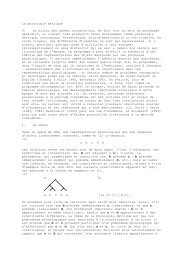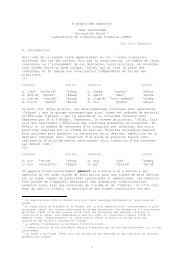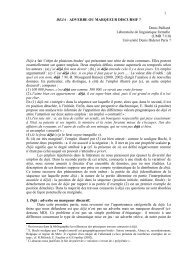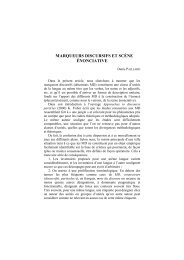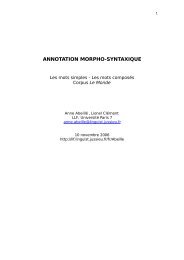CV as the only syllable type Jean Lowenstamm
CV as the only syllable type Jean Lowenstamm
CV as the only syllable type Jean Lowenstamm
Create successful ePaper yourself
Turn your PDF publications into a flip-book with our unique Google optimized e-Paper software.
A plausible interpretation of <strong>the</strong> differential mapping onto <strong>the</strong> "regular"<br />
and <strong>the</strong> putative "special" template for <strong>the</strong> forms at hand, appears in (7). Under<br />
<strong>the</strong> view just sketched out, <strong>the</strong> gemination in [jarra] results directly from <strong>the</strong><br />
shape of <strong>the</strong> hypo<strong>the</strong>sized template.<br />
(7)<br />
a. b.<br />
[C V][C V][C V] [C V C] [C V]<br />
| | | | | | | | \ / |<br />
k a t a b a j a r a<br />
However, (6) must be rapidly discarded on, at le<strong>as</strong>t, two grounds. First,<br />
consideration of fur<strong>the</strong>r forms of <strong>the</strong> same paradigm evidences identical<br />
arrangement of consonants and vowels for verbs from both kinds of root: sound<br />
in (8a), and deaf in (8b), thus weakening <strong>the</strong> plausibility of (6).<br />
(8)<br />
a. b.<br />
2m katab+ta [katabta] jarar+ta [jararta]<br />
1st katab+tu [katabtu] jarar+tu [jarartu]<br />
The second, perhaps even more compelling re<strong>as</strong>on to reject (6) h<strong>as</strong> to do<br />
with <strong>the</strong> very behavior of deaf roots in <strong>the</strong> first place: <strong>the</strong> charateristic spreading<br />
of C 2 unambiguously betrays <strong>the</strong> implementation of a template satisfaction<br />
requirement of <strong>the</strong> <strong>type</strong> convincingly argued for by McCarthy (1981). Indeed, in<br />
<strong>the</strong> absence of such a requirement, forms such <strong>as</strong> jara, jartu, etc. would be<br />
expected. The requirement of surface triliterality such that jarra and jarartu<br />
with two instances of C 2 , surface instead, strongly suggests that one and <strong>the</strong><br />
same template is being satisfied in <strong>the</strong> realization of verbs from both deaf and<br />
sound roots.<br />
Clearly, <strong>the</strong> template onto which deaf roots are mapped, <strong>as</strong>sumes no<br />
special shape. Ra<strong>the</strong>r, <strong>the</strong> decisive factor responsible for <strong>the</strong> presence or absence<br />
of a vowel between both instances of C 2 is <strong>the</strong> shape of <strong>the</strong> agreement marker:<br />
when <strong>the</strong> latter is V-initial, no vowel may appear "inside" <strong>the</strong> geminate (cf. 5b);<br />
when it is C-initial (cf. 8), a vowel must appear and no difference obtains any<br />
longer between verbs from sound and deaf roots. An account such <strong>as</strong> in (7b), too<br />
closely mirroring <strong>the</strong> audible evidence fails to capture what <strong>the</strong> forms of (5b)<br />
have in common with those of (8b) on <strong>the</strong> one hand, and with those of (5a) and<br />
(8a) on <strong>the</strong> o<strong>the</strong>r, viz. <strong>the</strong> expression of Category Form I Perfective.<br />
I submit that <strong>the</strong> appropriate representation of that category is <strong>as</strong> in (9),<br />
where a unique template is shown to accomodate representative examples of



